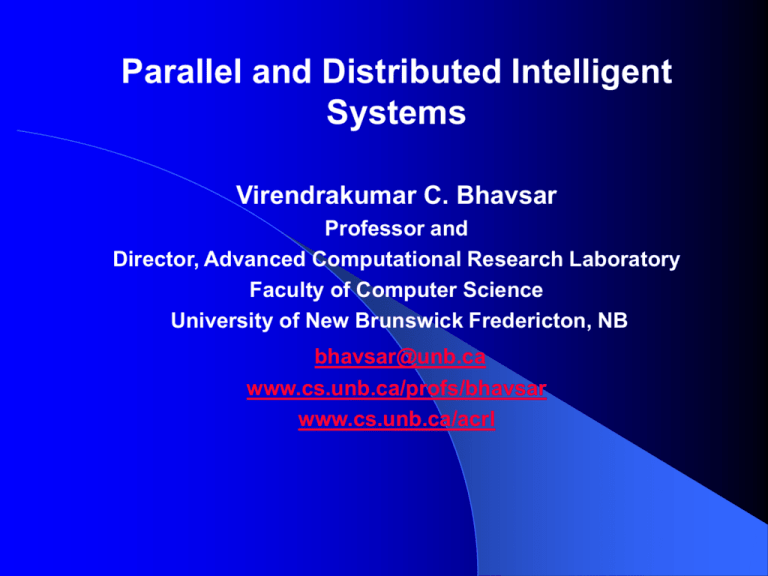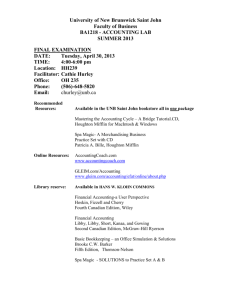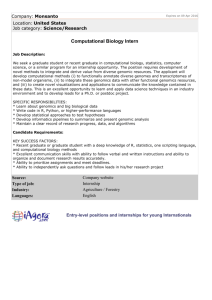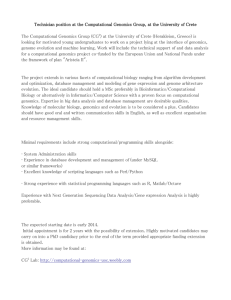Parallel and Distributed Intelligent Systems
advertisement

Parallel and Distributed Intelligent Systems Virendrakumar C. Bhavsar Professor and Director, Advanced Computational Research Laboratory Faculty of Computer Science University of New Brunswick Fredericton, NB bhavsar@unb.ca www.cs.unb.ca/profs/bhavsar www.cs.unb.ca/acrl Outline Past Research Work Current Research Work Conclusion Past Research Work Parallel/Distributed Processing - Parallel Computer Architecture - Design and Analysis of Parallel Algorithms - Real-time and Fault-Tolerant Systems Artificial Neural Networks Learning Machines and Evolutionary Computation Computer Graphics Visualization Advanced Computational Research Laboratory High Performance Computational ProblemSolving and Visualization Environment Computational Experiments in multiple disciplines: CS, Science and Eng. 16-Processor IBM SP3 Member of C3.ca Association, Inc. (http://www.c3.ca) Advanced Computational Research Laboratory www.cs.unb.ca/acrl Virendra Bhavsar, Director Chris MacPhee, Scientific Computing Support Sean Seeley, System Administrator ACRL’s IBM SP – 16 processors; 24 Gigabit Ethernet GFLOPS Disk 4 Winterhawk II nodes High Perforrnance Switch IBM SP at ACRL: The Clustered SMP Four 4-way SMPs Each node has its own copy of the O/S Processors on the node are closer than those on different nodes IBM Power3 SP Switch Bidirectional multistage interconnection networks (MIN) 300 MB/sec bi-directional 1.2 sec latency Past Research Work (cont.) Multimedia for Education: Intelligent Tutoring Systems Multi-Lingual Systems and Transliteration Web Portal with an Intelligent User Profile Generator Multi-Agent Systems Supervision/Co-supervision 50 master's theses; 4 doctoral theses 5 post-doctoral fellows/research associates Current Research Work Parallel/Distributed Processing -PaGrid: A Mesh Partitioner for Computational Grids - Dynamic Partitioning for Efficient Processing on Parallel Computers Multi-Agent Systems (Distributed Artificial Intelligence) - Multi-Agent System for Automatic Annotation of EST Sequences (funded by ‘The Canadian Potato Genomics’) - CS6999: Multi-Agent Systems - Dynamic Clustering of Agents in the Café - Agents with Ontology-based Keyphrases and Tree-distance algorithms - Scalability studies of Multi-Agent Systems - eCommerce applications Current Research Work eLearning (eduSorceCanada Project) - Reuse and exchange course content stored as “learning objects.’’ - Implementation and testing of learning objects using CanCore metadata -XML schema for content packaging - other projects What is a GRID System Cooperative network of shared resources - Includes computers, network links, human resources and databases Supports the development of advanced R&D applications in Science, Engineering and Technology Development, Finance and the Arts. March, 2000 Copyright (C) C3.ca 15 GRID Applications Large scale and resource intensive frontier applications – R&D applications that go beyond current technological capabilities – Technology development applications in multi-media, finance, production arts, hard sciences and engineering. - Multi-media applications such as embedded video, digital video servers and video conferencing. March, 2000 Copyright (C) C3.ca 16 Current C3.ca RP Network March, 2000 Copyright (C) C3.ca 17 The Canadian Potato Genomics Project ATLANTIC CANADA • 46% of national potato production $1 Billion/year • Home of McCain Foods Ltd. $5.5 billion/year • Potato Research Center of AAFC • Solanum Genomics International Inc. The Canadian Potato Genomics Project Research Areas • Bioinformatic Analysis • Access to resources via CBR membership/node status • Raw sequence processing and analysis by Fredericton bioinformatics group (Vector trimming, base calling, clustering, contig assembly, BLAST, an • Relational database management system of CPGP to link NRC (sequencing), CBR and researchers • In silico assignment of gene function • Microarray data The Canadian Potato Genomics Project Research Areas • Bioinformatic Research To Suit Project Needs (UNB): • Autonomous agent development to automatically update sequence annotations • Enhancement of bioinformatic algorithm performance with parallel computing • Algorithm development using annotation information to enhance sequence searching • The application of clustering and learning techniques to the analysis of expression data tom@ucsd.edu ymasrour@ai.it.nrc.ca ucsd.edu ai.it.nrc.ca S e r v e r S e r v e r bob@ai.it.nrc.ca dick@ucsd.edu steve@ai.it.nrc.ca Café anwhere.else foo@anywhere.else Café S e r v e r cs.stir.ac.uk meto.gov.uk S e r v e r S e r v e r Café Clients wibble@cs.stir.ac.uk graham@cs.stir.ac.uk anne@cs.stir.ac.uk joan@unb.ca bhavsar@unb.ca Performance Evaluation of ACORN Test-bed: Several Autonomous Servers, each serving autonomous virtual users Virtual User - capable of creating agents - picks up a topic from a client core’s interest - migrates to other servers - potential destinations Performance Evaluation of ACORN 120 Time (Seconds) 100 80 60 40 20 0 0 0 20 40 60 Number of Agents 80 Mingle Tim e with cosine Total Exection Time with cosine Mingle Tim e for without cosine Total Exection Time without cosine 100 Why learning objects? • COST: 1000s of colleges have common course topics • large numbers of courses are going online • World does not need 1000s of similar learning topics • World needs only about a dozen • Expensive to develop so sharing is essential (From Downes, 2000) What is METADATA? data about data Metadata standards are agreed-on criteria for describing data to support interoperability Example: January 31, 2001 31 janvier 2001 2001-01-31 01-31-2000 31012000 Metadata and RDF implementation * XML * Resource Description Framework (RDF) = structure Metadata = semantics & resources Conclusion Parallel/Distributed Processing Multi-Agent Systems (Distributed Artificial Intelligence) NSERC Project, The Canadian Potato Genomics Project eLearning (eduSorceCanada Project) Automated and manually-driven user profile generation and update




